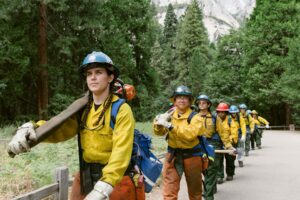This program is blazing a trail for women in wildland firefighting
On a sunny morning in early August, a group of seven women dressed in hard hats and yellow long-sleeve shirts marched single file, carrying chainsaws, axes and other hand tools toward a thicket of pine trees. In the background loomed Yosemite National Park’s characteristic granite monoliths.
When they arrived, their supervisors gave them their assignment for the day: building burn piles on the floor of Yosemite Valley.
Guadalupe Ruiz put on her safety goggles and gloves. With her hair pulled back in two long braids, she began to hack away at a towering pile with a chainsaw, while other crew members dragged logs and branches full of green pine needles across the forest floor to form other piles, which will be set on fire later in the season when the weather is less fire-prone. This type of maintenance is an essential component of fire management, allowing fuels to be burned in a controlled manner rather than becoming part of a larger, more destructive fire later on.
But though the maintenance is routine, this crew who carried it out is uncommon: They were all women. The Yosemite Women’s Fire Internship is part of a new pilot program launched last year to bring more women into wildland firefighting in the National Park Service (NPS).
As wildfires worsen due to climate change and states like California deal with a growing shortage of firefighters, the need to diversify the workforce is as much about practicality as it is about equity. Only about 12 percent of wildland firefighters are women, and even less ascend to leadership positions, with women making up less than 5 percent of NPS wildland fire leadership at the park level.
Working in wildland firefighting also opens up opportunities in other fields related to natural resource management, said Robin Verble, a researcher at the Missouri University of Science and Technology.
“It’s one of the most open gates into natural resource professions out there in terms of job availability,” she said. “If women are to get into natural resources and in ecology and in those kinds of fields and want to get into the federal system, it’s making sure that gate is up.”
Those other types of jobs, which could range from forest or fire ecology to wildlife management, are also exciting to Ruiz, who has a degree in wildlife biology. And the Yosemite training aims to expose her and the rest of the crew to other kinds of jobs in the park. While the crew worked on the burn piles, a woman park biologist was sent to talk to them about her job and to discuss recent bear activity in the area. Ruiz peppered her with questions, excited to learn more about her work.
Still she and other corps members expressed a sense of duty when it came to fighting fires. “I want to help out because there is this great need of people and I can do it. My body is able to do this work,” she said.
But like other fields dominated by men, societal bias and discrimination have made it difficult to grow and retain the number of women like Ruiz in the field. The 10-week Yosemite program — plus all-women crews in Wyoming’s Grand Teton National Park and a newly launched program in Alaska’s national parks — is aiming to provide a smoother entry for women, giving them the opportunity to become certified for federal wildland firefighting in a more welcoming environment.
